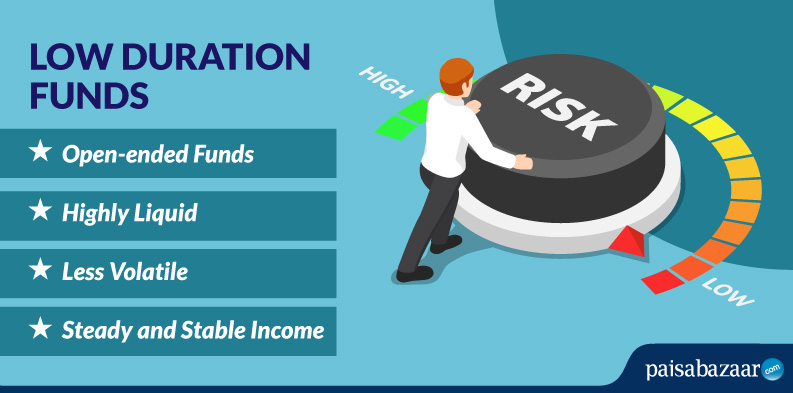A large number of investors indulge into savings accounts instead of investing into Mutual funds because of market risk. However, Low duration funds are liquid as well as less risky which makes them suitable for individuals who are conservative about their resources. And at the same time these funds help investors gain from interest rate changes and higher returns.
What are Low Duration Mutual Funds?
Low Duration funds are the open-ended debt mutual funds which invest in money markets and debt securities, with Macaulay duration between 6 to 12 months. The maturity period for these mutual funds is comparatively higher than the liquid and ultra-short term funds.

Advantages of investing in Low Duration Funds
- Higher Returns
Low duration funds have outperformed liquid funds with their approach towards taking duration exposure and greater credit. These funds have the potential to outperform ultra short duration funds by making comparatively higher capital gains. Investors of low duration funds can enjoy steady returns which usually range between 6.5% to 8.5%. If invested in a good low duration fund, the returns accrued will not just beat the benchmark but the peers as well.
- Less Risky
These funds have a low or moderate degree of risk involved because of inclined allocation of assets towards securities which have maturity less than 1-1.5 years. However, Low Duration Funds, as a type of debt funds, have credit, interest and liquidity risk. The returns from such funds can face downturns in case of asset allocation in low credit rated securities
Things to be considered before investing in Low Duration Funds
Given below are some important factors which must be taken into consideration before processing investments-
- Financial Goal: Your financial goal is what stems your investment decisions. So, funds should be chosen keeping the end goal in mind. It is suggested that one should not park their emergency funds in Low duration schemes. Instead, you can choose short duration funds or medium funds according to the requirements
- Returns: Best Low Duration funds have the potential to perform efficiently and beat the returns accrued by their benchmark. If you are planning to invest in a low duration fund, you can evaluate its performance over a period of 6 months to 1 year and see if it has given satisfactory returns or not
- Investment Horizon: For what duration would you want to park your funds? Investors with more than 3 months investment horizon can opt for low duration funds. However, you can earn better returns if you keep yourself invested for a longer duration
- Risk Tolerance: These funds might have moderate risks involved but they are not entirely risk free. Investors must track the degree of risk and duration of the fund to evaluate if there is an increase in its interest rate risk. The portfolio must also be analysed to assess the credit quality of fund’s holdings
- Fund Portfolio & Management: Who is the fund manager? What is his/her investment strategy and stock-picking approach? These are some basic questions which must be researched and answered carefully before choosing a mutual fund. Low duration funds are actively managed in order to get satisfactory returns. Thereby, you must study about the fund’s portfolio and fund managers to ensure that your funds are in safe hands
- Expense Ratio and other costs: The annual amount charged in favour of management of the portfolio is called Expense Ratio. According to the norms of Securities and Exchange Board of India (SEBI), maximum 1.05% expense ratio is applied on the Low Duration Funds. One must keep a track of the expense ratio involved in a fund to avoid paying excess charges
Tax Treatment for Low Duration funds
Under these mutual funds, Short-term Capital Gains (STCG) are taxed on the basis of the income slab of the investor. On the other hand, no tax is applied on the dividend but 20% tax after the benefit of indexation is applied in the case of Long-Term Capital Gains (LTCG).
Who Should Invest in Low Duration Funds?
Low duration funds are considered as one of the best investment options for investors who are not willing to risk their investments.
- Investors having any kind of repugnance for volatile funds should invest in these funds for a short-term and still earn better returns on investment than savings accounts
- The returns generated under Low Duration funds are, typically, stable and steady. The average returns accrued by these funds is 6.5 to 8.5 per cent p.a.
- In case the interest rates move up, the funds will bear capital losses
Best Low Duration Funds 2020
Here is a list of top 10 low duration funds in India-
| Fund Name | AUM (Crores) | 3 Year Returns | 5 Year Returns |
| Kotak Low Duration Fund | Rs. 6,781 | 8.46% | 8.97% |
| ABSL Low Duration Fund | Rs. 10,725 | 8.25% | 8.59% |
| ICICI Prudential Savings Fund | Rs. 22,569 | 7.92% | 8.36% |
| Axis Treasury Advantage Fund | Rs. 5,239 | 8.11% | 8.35% |
| IDFC Low Duration Fund | Rs. 5,804 | 7.79% | 8.23% |
| Invesco India Treasury Advantage Fund | Rs. 1,869 | 7.90% | 8.21% |
| HDFC Low Duration Fund | Rs. 15,641 | 7.71% | 8.19% |
| SBI Magnum Low Duration Fund | Rs. 9,751 | 7.74% | 8.04% |
| Canara Robeco Savings Fund | Rs. 1,135 | 7.51% | 7.94% |
| DSP Low Duration Fund | Rs. 3,135 | 7.93% | – |